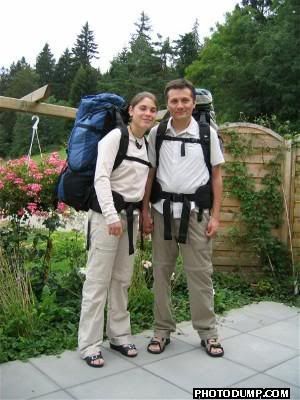Friday, January 28, 2005
Thailand: Karen county
Our next adventure took us along the Burmese border, from Umphang, in the Tak province, to Mae Hong Son, on the Northeast corner of Thailand. This area is inhabited by Karen people, Thais, Shans and other minorities.
Trekking
We started our journey by a 4 days trek in the jungle around Umphang. The area is much less touristy than other trekking regions of the North. It was an enjoyable experience.
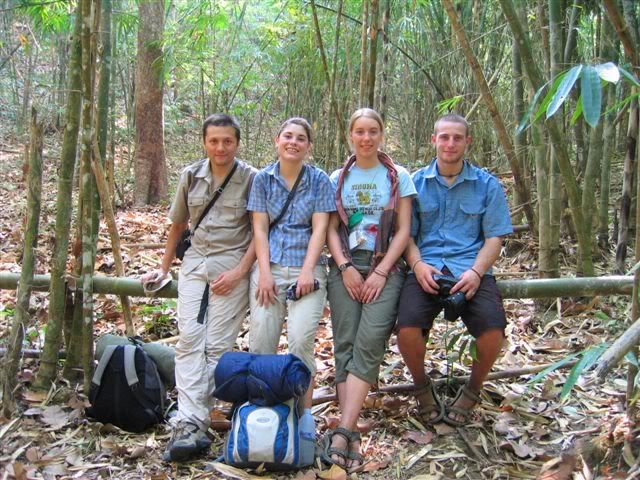
We were a small group of 4 tourists and 3 Karen guides, who took good care of us. They provided us with plenty of background information on plants, animals, and their culture, as well as good cooking and corny jokes.
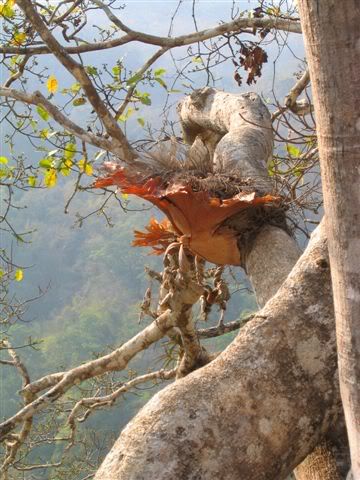
The first day was spend on a rubber boat, with stops for cave exploration, hot spring bath and camping. On the second day, more serious trekking began to and around the Tee Lor Su waterfalls (the "biggest" in Thailand!). On the 2 last days, we went into the hills across evergreen forests to a traditional Karen village (see below).
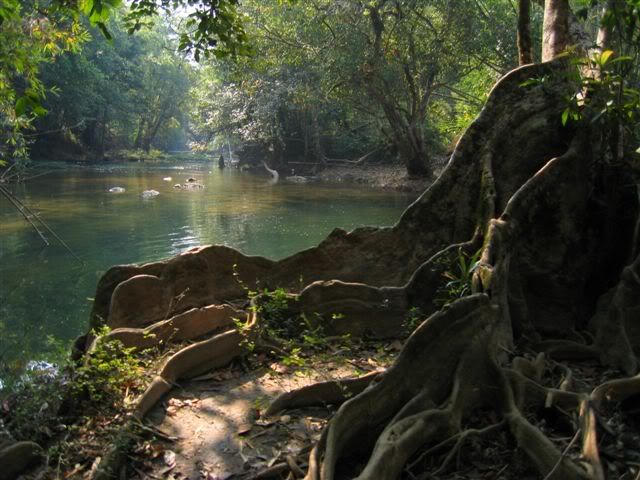
The Karen
The Karen live in the hills of the border region between Burma and Thailand. They are approximately 7 million in Burma, and 500'000 in Thailand. They have their own language and alphabet. Most of them are still animists and live according to a complex systems of rules and taboos. They are usually shy and tend to keep to themselves, which may help them protect their culture from outside influence.
Many traditional Karen villages dot the border. They belong to different subgroups, which can be distinguished by their clothes, and sometimes physical characteristics (long-neck padaung minority and "big ear" Karen). On our Umphang trek, we had the chance to stay at the chief's house in a relatively remote one, Tee Po Ji, far from the trekking industry's highways.
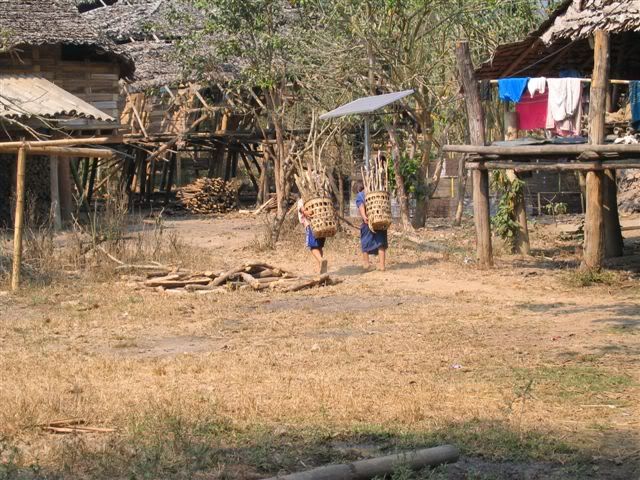
On a sader note, in Burma, the Karen have been fighting for their independence for over 50 years. Forced labour, rasing of villages, and other systematic violences by the burmese dictatorship has caused over 120'000 to flee over to Thailand where they crowd the refugee camps along the border. Many of these people have been living in such camps for 2 or 3 generations, without being recognised as citizen of either country.
The road
The way up North across the hills and valleys was an experience in itself. The "Sky Highway" between Umphang and Mae Sot is a winding, 4 hour rollercoaster across a scarcely inhabited region (except for the new village of Umpium where 20'000 Karen of different refugee camps were relocated). The only means of public transportation there are modified pick up truck, the songthaews:
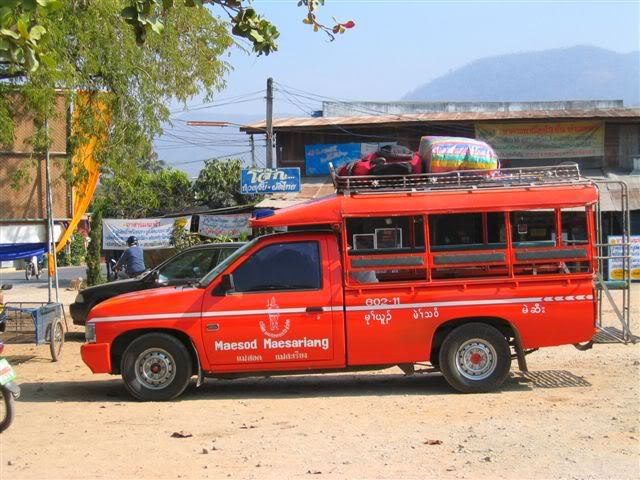
There is not much to say about Mae Sot, a typical border town and mixture of thai, burmese and european influences (many NGO's working in the camps have offices in town). Most tourists who go there just do the visa run across the border to renew their 30 days Thai visas. The burmese border post sells 1-day visas for the market village of Myawaddy, just across the friendship bridge. The village is nothing special: a few dirty markets, some mock-ups of chinese business buildings and tacky concrete pagodas.
The road from Mae Sot to Mae Sariang takes another 6 hours to travel by songthaew. Not many proper villages, some more camps, hills, forests and police control posts. The laid-back village of Mae Sariang, where we spent 2 nights, has some pretty burmese style temples.
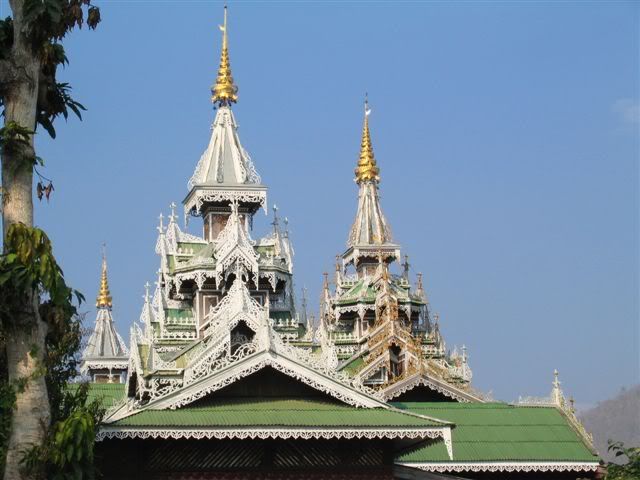
The road to Mae Hong Son has got more traffic, most of which coming from Chiang Mai, and can be travelled by bus.
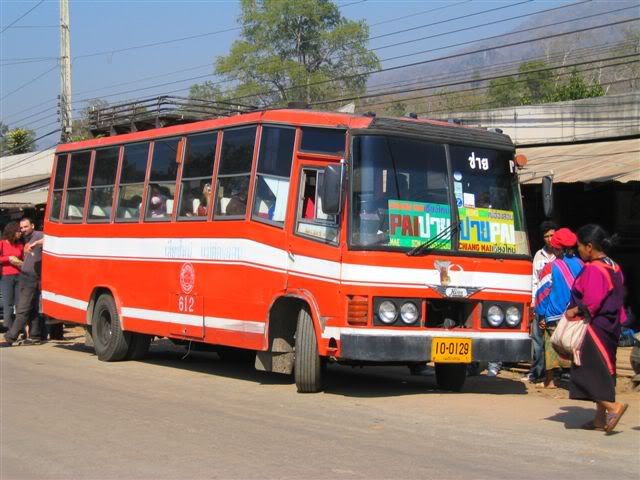
Mae Hong Son is a small administrative and tourist centre with its own regional airport. The town has quite a few burmese and shan style temples, and is a good base to explore the region by motorbike.
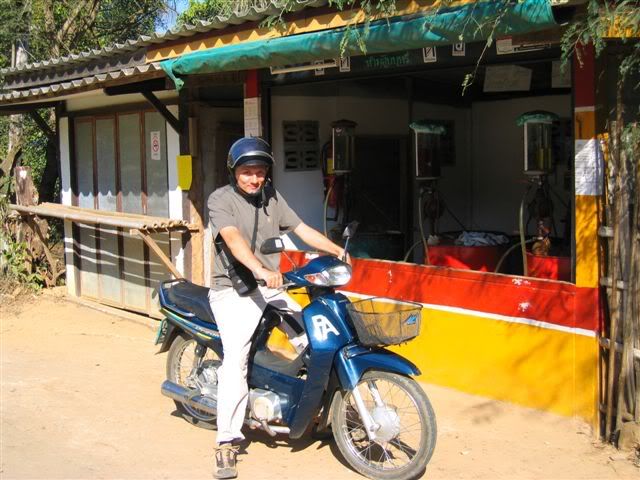
Beside Karen villages, other minorities start to appear on the map. Lisu, Lawa, Meo and Kuomintang military who fled China after their defeat in 1949 and set base there waiting to reconquer their country... Hill tribe people at the market in Soppong, 60km from Mae Hong Son:

Until recently, most of these minorities lived from the opium trade. Now, under the pressure of the government, who regained control over the region, they have had to replant the poppy fields with less rentable crops like coffee and tea. The burmese border near the Kuomintang village of Mae Aw:
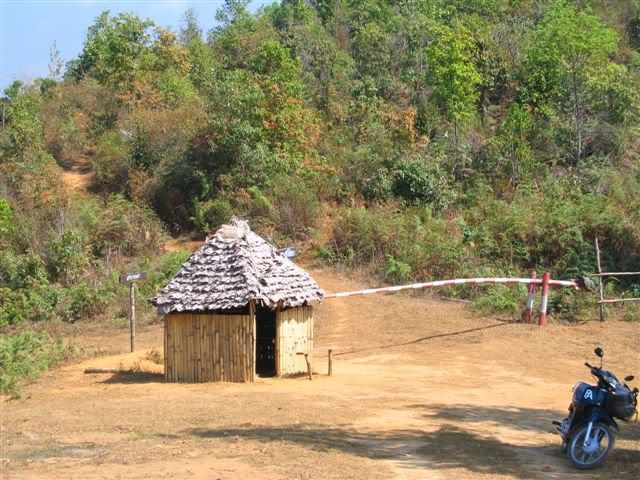
...a Meo village:
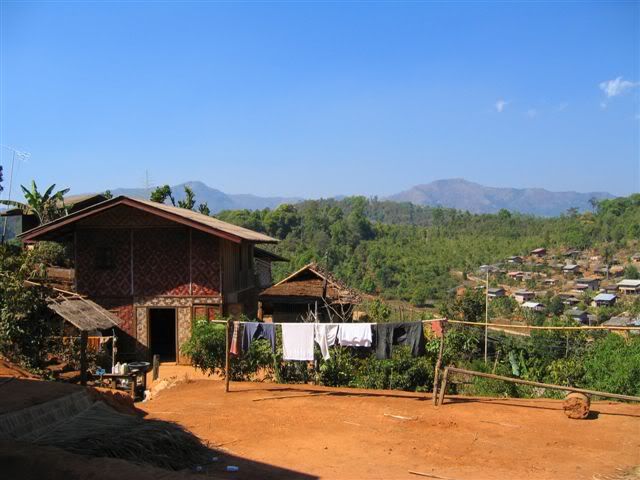
Trekking
We started our journey by a 4 days trek in the jungle around Umphang. The area is much less touristy than other trekking regions of the North. It was an enjoyable experience.

We were a small group of 4 tourists and 3 Karen guides, who took good care of us. They provided us with plenty of background information on plants, animals, and their culture, as well as good cooking and corny jokes.

The first day was spend on a rubber boat, with stops for cave exploration, hot spring bath and camping. On the second day, more serious trekking began to and around the Tee Lor Su waterfalls (the "biggest" in Thailand!). On the 2 last days, we went into the hills across evergreen forests to a traditional Karen village (see below).

The Karen
The Karen live in the hills of the border region between Burma and Thailand. They are approximately 7 million in Burma, and 500'000 in Thailand. They have their own language and alphabet. Most of them are still animists and live according to a complex systems of rules and taboos. They are usually shy and tend to keep to themselves, which may help them protect their culture from outside influence.
Many traditional Karen villages dot the border. They belong to different subgroups, which can be distinguished by their clothes, and sometimes physical characteristics (long-neck padaung minority and "big ear" Karen). On our Umphang trek, we had the chance to stay at the chief's house in a relatively remote one, Tee Po Ji, far from the trekking industry's highways.

On a sader note, in Burma, the Karen have been fighting for their independence for over 50 years. Forced labour, rasing of villages, and other systematic violences by the burmese dictatorship has caused over 120'000 to flee over to Thailand where they crowd the refugee camps along the border. Many of these people have been living in such camps for 2 or 3 generations, without being recognised as citizen of either country.
The road
The way up North across the hills and valleys was an experience in itself. The "Sky Highway" between Umphang and Mae Sot is a winding, 4 hour rollercoaster across a scarcely inhabited region (except for the new village of Umpium where 20'000 Karen of different refugee camps were relocated). The only means of public transportation there are modified pick up truck, the songthaews:

There is not much to say about Mae Sot, a typical border town and mixture of thai, burmese and european influences (many NGO's working in the camps have offices in town). Most tourists who go there just do the visa run across the border to renew their 30 days Thai visas. The burmese border post sells 1-day visas for the market village of Myawaddy, just across the friendship bridge. The village is nothing special: a few dirty markets, some mock-ups of chinese business buildings and tacky concrete pagodas.
The road from Mae Sot to Mae Sariang takes another 6 hours to travel by songthaew. Not many proper villages, some more camps, hills, forests and police control posts. The laid-back village of Mae Sariang, where we spent 2 nights, has some pretty burmese style temples.

The road to Mae Hong Son has got more traffic, most of which coming from Chiang Mai, and can be travelled by bus.

Mae Hong Son is a small administrative and tourist centre with its own regional airport. The town has quite a few burmese and shan style temples, and is a good base to explore the region by motorbike.

Beside Karen villages, other minorities start to appear on the map. Lisu, Lawa, Meo and Kuomintang military who fled China after their defeat in 1949 and set base there waiting to reconquer their country... Hill tribe people at the market in Soppong, 60km from Mae Hong Son:

Until recently, most of these minorities lived from the opium trade. Now, under the pressure of the government, who regained control over the region, they have had to replant the poppy fields with less rentable crops like coffee and tea. The burmese border near the Kuomintang village of Mae Aw:

...a Meo village:

Comments:
https://kumarvisas.com/usa-b1b2-visa-renewal-consultants/Get Your visa renewal done in less than 3 hours from the time you make your embassy payment. payment after processing your application. we deal with american USA visa renewal services in India mainly in Hyderabad Delhi Mumbai Chennai kolkata.
Post a Comment
<< Home
https://kumarvisas.com/usa-b1b2-visa-renewal-consultants/Get Your visa renewal done in less than 3 hours from the time you make your embassy payment. payment after processing your application. we deal with american USA visa renewal services in India mainly in Hyderabad Delhi Mumbai Chennai kolkata.
<< Home

